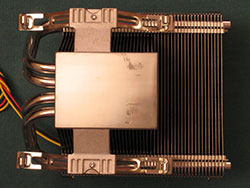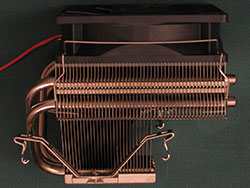Investigations into Socket 939 Athlon 64 Overclocking
by Jarred Walton on October 3, 2005 4:35 PM EST- Posted in
- CPUs
Case and CPU Cooling
For the case, things are a bit more straightforward. The cheapest cases can still work fine for any system, though they're usually more difficult within which to work, may have sharp edges, may be noisy, and could even warp or bend. As with power supplies, you get what you pay for. We'd suggest getting a case that has at least two 120mm fan locations, one in the front of the case and one in the rear. If you use 80mm fans, you pretty much need two 80mm models to equal the flow rate of a 120mm model. Blow holes on the top, bottom and side of the case can be added if you really want, though the effectiveness varies. What you really want is to get a nice flow of air going through the case without a lot of turbulence. A single 120mm fan at the front of the case acting as an intake with a second 120mm fan at the rear blowing out is generally adequate, once you add in the PSU fan, which would also be blowing out. Going beyond that to get more air flow is possible, but you get diminishing returns and increased noise. We've seen cases with seven fans all blowing in different directions that couldn't overclock at all, so more is definitely not always better.
We used an (old) Antec SX635BII for our testing, equipped with three 80mm fans. A case with two 120mm fans like the Antec SLK3700-BQE would be a bit quieter, though we didn't focus on noise levels as part of the setup. Antec cases can be really heavy, as they're built of thick steel, but they're also easy to work within. If you plan on moving your PC around a lot or putting it on top of your desk, we'd definitely recommend getting a lighter case - perhaps a SFF might be an option, if you can afford the luxury. I've picked up the massive Thermaltake Armor with a full system installed, and it was still noticeably lighter than either the Antec SX635BII or the SLK3700-BQE. (I can't comment on which is easier to work with, as the Armor system was assembled by someone else.)
Lastly, you need a decent cooler for the CPU. The stock AMD cooler will get the job done for basic overclocking, but if you want to get above 2.3 or 2.4 GHz, you'll need better. There are many options out there right now, but unlike other components, a more expensive cooler may not actually be better. Solid copper designs cost more and should cool a bit better (due to their lower specific heat and increased mass), but there's no guarantee. For overall cooling quality at a reasonable cost, we'd go with either a Zalman CNPS7000B (either the AlCu or Cu version is fine) or else get a Thermalright XP-90 with a Panaflo 92mm M1A fan. With shipping, either option should run $33 to $45, give or take. The Zalman is probably a bit quieter and it comes with a fan speed control while the Thermalright is much easier to mount onto the CPU in our opinion.
We used the aluminum version of the Thermalright XP-90, as the copper model costs about $15 more and doesn't really improve the cooling performance much. If you have another favorite HSF, you can get that instead. During our testing - even with an X2 overclocked to 2.7 GHz - the heat sink never even became very warm to the touch. As an added bonus, on the particular motherboard that we're using, the HSF overhangs the two RAM slots that we populated, so the RAM should also get more air movement than in other designs. Sure, it makes installing and removing RAM a bit trickier, but it wasn't difficult at all.
For the case, things are a bit more straightforward. The cheapest cases can still work fine for any system, though they're usually more difficult within which to work, may have sharp edges, may be noisy, and could even warp or bend. As with power supplies, you get what you pay for. We'd suggest getting a case that has at least two 120mm fan locations, one in the front of the case and one in the rear. If you use 80mm fans, you pretty much need two 80mm models to equal the flow rate of a 120mm model. Blow holes on the top, bottom and side of the case can be added if you really want, though the effectiveness varies. What you really want is to get a nice flow of air going through the case without a lot of turbulence. A single 120mm fan at the front of the case acting as an intake with a second 120mm fan at the rear blowing out is generally adequate, once you add in the PSU fan, which would also be blowing out. Going beyond that to get more air flow is possible, but you get diminishing returns and increased noise. We've seen cases with seven fans all blowing in different directions that couldn't overclock at all, so more is definitely not always better.
We used an (old) Antec SX635BII for our testing, equipped with three 80mm fans. A case with two 120mm fans like the Antec SLK3700-BQE would be a bit quieter, though we didn't focus on noise levels as part of the setup. Antec cases can be really heavy, as they're built of thick steel, but they're also easy to work within. If you plan on moving your PC around a lot or putting it on top of your desk, we'd definitely recommend getting a lighter case - perhaps a SFF might be an option, if you can afford the luxury. I've picked up the massive Thermaltake Armor with a full system installed, and it was still noticeably lighter than either the Antec SX635BII or the SLK3700-BQE. (I can't comment on which is easier to work with, as the Armor system was assembled by someone else.)
Lastly, you need a decent cooler for the CPU. The stock AMD cooler will get the job done for basic overclocking, but if you want to get above 2.3 or 2.4 GHz, you'll need better. There are many options out there right now, but unlike other components, a more expensive cooler may not actually be better. Solid copper designs cost more and should cool a bit better (due to their lower specific heat and increased mass), but there's no guarantee. For overall cooling quality at a reasonable cost, we'd go with either a Zalman CNPS7000B (either the AlCu or Cu version is fine) or else get a Thermalright XP-90 with a Panaflo 92mm M1A fan. With shipping, either option should run $33 to $45, give or take. The Zalman is probably a bit quieter and it comes with a fan speed control while the Thermalright is much easier to mount onto the CPU in our opinion.
 |
 |
| Click to enlarge. | |










101 Comments
View All Comments
photoguy99 - Monday, October 3, 2005 - link
Dual Core was not mentioned -Anyone know how difficult it is to get a stable dual-core to 2.8Ghz with water-cooling?
Easy, difficult, impossible?
JarredWalton - Monday, October 3, 2005 - link
Part two/three will cover other chips. I wanted to get the base overclocking article out, and I will be looking at both Sempron and X2 overclocking in the near future. 2.80 GHz wasn't stable on my Venice, though - not entirely - and it won't even post on my X2 3800+. Your mileage may vary, naturally, but I'm getting about 100MHz less from my X2 vs. Venice. (I'd take the second core over the extra 100MHz any day, however!)MemberSince97 - Monday, October 3, 2005 - link
Thanks for the detailed explanation and charts. Thanks for the hard work.Nunyas - Monday, October 3, 2005 - link
I'm a bit supprised that you guys forgot to mention the overclocking abilities of the venerable Athlon Thunderbirds with the AXHA and AXIA steppings. I had a 1GHz T-Bird with AXHA stepping that allowed me to OC it to 1.533 GHz (53%), and it's documented all over the place with people achieving even better results with the same model CPU. At the time that the 1GHz became a great OC'er it was around $99 and gave you the performance of the then high end Athlons and P4's. Thus, by far a better OC'er than the Celeron 300A.OvErHeAtInG - Monday, October 3, 2005 - link
Meh, my AXIA 1.2 would do 1.4 or 1.33 sorta stable, with really good cooling, tweaked voltage, and so forth. When I sold it to my friend I had to put it back to stock speeds just so it would stay stable in the hands of someone who doesn't monitor her CPU temperature all the time ;) My "B" Northwood, IMO, is a more stable OC'er. Having said that, I guess others were more lucky than me... but yeah no 300A killer IMO.kmmatney - Monday, October 3, 2005 - link
The celeron 300A set the standard for overclocking. It was less the $100 (oem version) and performed better than any stock cpu you could buy, including those costing 3 times more. It really sparked the whole overclocking phenonema. Another good one was the Celeron II 500, which could easily overclock to 800 MHz. I had both of those.I had a cyrix 486DX-66 overclocked to 80 Mhz, and an AMD 586 DX4-133 overclocked to 150 MHz, but the celeron 300A was simply unbelievable at the time.
JarredWalton - Monday, October 3, 2005 - link
I didn't bother to try and include everything, especially where it was only specific steppings of a CPU. (I.e. not all T-birds did a 53% OC, right?) Anyway, I was basically an Intel user up until the Athlon XP era. I went from socket 478 with a Celeron 1.1A (OC'ed to 1.47 GHz) to the XP-M 2500+. The "history lesson" was just an introduction anyway, setting the stage. :)Aquila76 - Monday, October 3, 2005 - link
I've been waiting for a reputable site to post OC testing like this. I feel pretty good with the OC I get out of my rig (3500+ Winch @ 2.7GHz, Mem on divider) - thanks to the forums here - and it's close to what you guys acheived. I may swap to that DFI board instead as I know the A8N-SLI is holding me back.Garyclaus16 - Monday, October 3, 2005 - link
Job well done. I like how the benchmarks showed overclocking for anything 1024x768+ means nothing for games. I was aware the increase was small with high resolution..but an almost null increase in performance kind of makes me want to leave my 3200+ winchester the way it is. Do the venice cores OC better than winchesters?...JarredWalton - Monday, October 3, 2005 - link
Venice and Winchester should be about the same, though you might get an extra 100 MHz out of Venice (?). You can get higher performance at resolutions above 1024x768, but you'll need a much faster graphics card than the X800 Pro (or a 6800GT) for most of that. It depends on the game being tested as well.